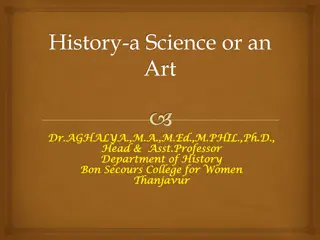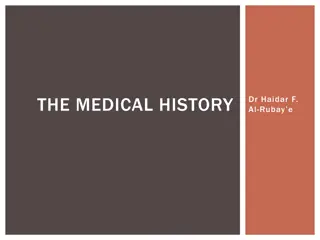Understanding Pharmacovigilance: Importance and History
Delve into the world of pharmacovigilance through this insightful presentation covering topics such as the need for pharmacovigilance, risk/benefit balance of medications, WHO definition, detection of adverse effects, and learning from past disasters like the Thalidomide case. Explore why pharmacovigilance is crucial in ensuring medication safety and understanding its significant impact on public health.
Download Presentation

Please find below an Image/Link to download the presentation.
The content on the website is provided AS IS for your information and personal use only. It may not be sold, licensed, or shared on other websites without obtaining consent from the author. Download presentation by click this link. If you encounter any issues during the download, it is possible that the publisher has removed the file from their server.
E N D
Presentation Transcript
Introduction to Pharmacovigilance
Outlines of the presentation Smooth orientation to pharmacovi gilance Important terminologie s in pharmacovi gilance WHO Why dowe need pharmacovi gilance? Yellow Card & BlueCard Pharmacovi gilance in Egypt programme for drug monitoring Workshop
MedicineSafety T o undergo treatment you have to be very because, apart from your sickness you withstandthe medicine healthy, have to Moli re
Risk/Benefit Balance ofmedications Medicines aresafe! (X) Approved medicines aresafe! (X) No medicine issafe! (X) No medicine is withoutrisk ( )
Risk/Benefit Balance ofmedications Acceptable Unacceptable
WHO definition of pharmacovigilance Pharmacovigilance is the science and activities detection, understanding of adverse effects or any other medicine-relatedproblem relating to the assessment, and prevention
Detection Assessment &Understand ing prevention of adverse effects Pharmacovigilance
Learning fromHistory Thalidomide Disaster: Tranquilizer launched -1957 Firstreports of birthdefects - 1959 13reports of birthdefects - 1961 Withdrawn shortlyafterward 10000 infants affected by Phocomelia. No teratogenicity detected in testis during clinical trials and prior to launch.
Why do we need Pharmacovigilance?
Reason1: Humanitarianconcern Insufficient evidence ofsafety from clinical trials, Animal experiments & Phase 1 3 studies prior to marketing authorization
Limitations of clinicaltrials Small number ofpatients studied Restricted populations(age, sex,ethnicity) Narrow indications Short duration ofdrug exposure
Reason2: Medicines are supposedto savelives Dying from a disease is sometimesunavoidable; dying from a medicineis unacceptable. Lepakhin V . Geneva2005
USA ADRs were 4th-6th commonest cause of death in the US in1994 Lazarou et al,1998 UK It has been suggestedthat ADRs may cause 5700 deaths per year inUK. Pirmohamed et al,2004
Reason3: ADRsareexpensive!! Cost of drug related morbidity andmortality exceeded$177.4 billion in2000 (ErnstFR& GrizzleAJ,2001:JAmericanPharm. Assoc). ADR related cost to the country exceeds the cost of the medicationsthemselves.
Reason 4: Promoting rational use of medicines and adherence Reason5: Ensuringpublicconfidence Reason6: Ethics T o know of something that is harmful to another person who doesnot know,and not telling, isunethical
Pharmacovigilance is needed in every country becauseof differencesin: Drugproduction Distribution and use ( e.g. indications, dose,availability) Genetics, diet, traditions of the people (e.g. remedies,etc.) Pharmaceutical composition ingredients) use of herbal quality (active/inactive and
Who program for international drug monitoring
Who program for international drug monitoring Started1968 Located inUppsala, Sweden Collaborating centrefor maintaining global ADR database -Vigibase
Roles of WHO CollaboratingCentre Identify early warning signals of seriousadverse reactions to medicines Evaluate the hazard Undertake research into the mechanisms ofaction to aid the developmentof safer and more effective medicines
Important Terminologies in Pharmacovigilance
Side Effect (SE) Vs Adverse Drug Reaction (ADR) Vs Adverse Event(AE) SE Response to a drug which is unintended and which occurs at doses normally used in man for prophylaxis, diagnosis or therapy of disease. AE Any untoward medical occurrence in a patient or clinical investigation subject administered a medicinal product andwhich does not necessarily have to have a causal relationship withthis treatment. ADR Response to a drug which is noxious and unintended and which occurs at doses normally used in man for prophylaxis, diagnosis or therapy of disease A causal relationship between the drug and the occurrence is suspect.
Adverse Drug Reaction (ADR) Vs Adverse Event(AE)
Medication Errors(ME) Medication errors are morecommon than adverse events, but result in harm less than 1% of the time. About 25%of adverse events are due to medicationerrors. They could occur during prescribing, transcribing, dispensing, administering a drug. Examples of medication errors include, misreadingor miswriting a prescription. Not all medication errors leadto adverse outcomes.
Adverse Drug Reactions (ADR) vs Adverse Events (AE) vs Medication Errors(ME)
Seriousness of Adverse drugreactions SeriousADR Life-Threatening Hospitalization (initial orprolonged) Disability Death CongenitalAnomaly Medically important event orreaction CauseCancer OTHER WISE ADR ISNON-SERIOUS
Serious reports should be submitted in manner i.e. as soonas possible & no later than 15 calendar days. Thustheybestsubmitted OnlineEmailorFax expedited
A V ALID REPOR T CONSISTSOF:- Identifiablepatient Identifiable drug (pharmaceuticalproduct) Identifiablereaction Identifiablereporter
Who shouldreport? HealthcareProfessionals Marketingauthorization holder(MAH) Patients & theirrelatives Nurses Pharmacists
Reports Journey Reporter QPPV Dataentry RA























